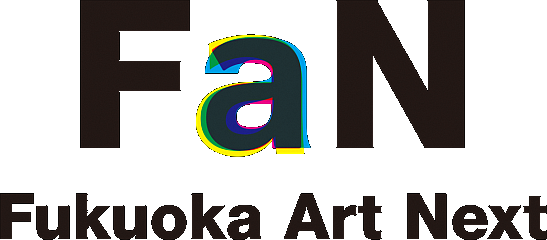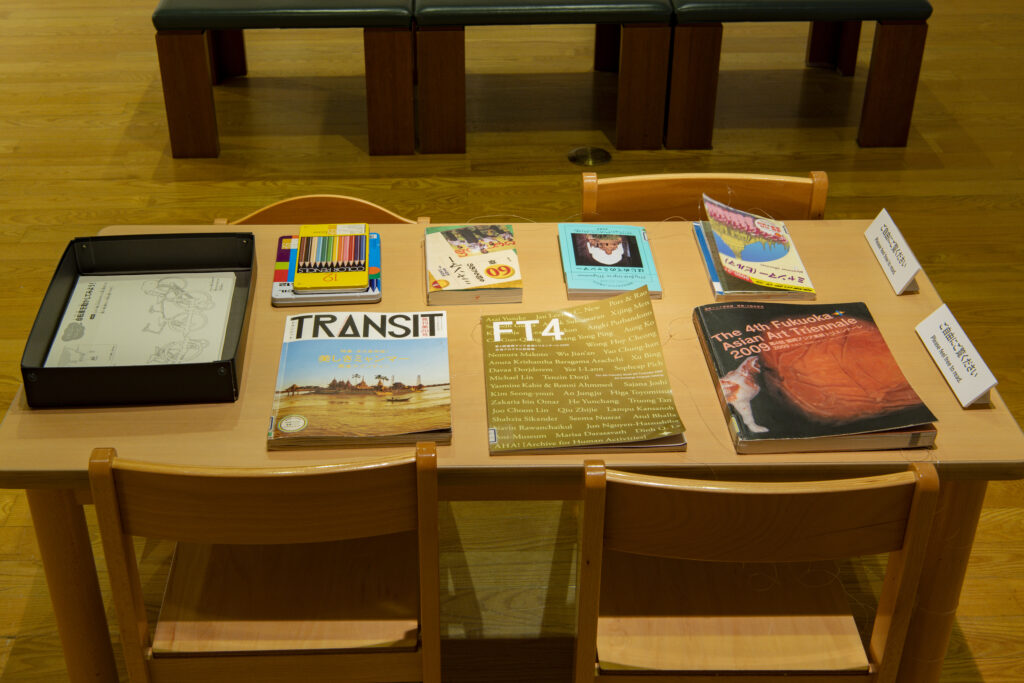
Room for FAAM Residence Program Part Ⅱ: Artists in Myanmar Today―Aung Ko
- Period
- Sep 14, 2024 〜 Dec 17, 2024
- Venue
Asia Gallery
Since opening in 1999, Fukuoka Asian Art Museum (FAAM) has been conducting its annual Residence Program, inviting artists and researchers from Asia for a period of time that enables them to interact with citizens through collaborative art-making, workshops, and talk events. In 2022, as part of Fukuoka Art Next (a new governmental policy that supports emerging local artists and artistic activities), FAAM renewed this program and invited eight artists (including duos) across Japan and worldwide through its open call for them to work at the newly located studio in Artist Cafe Fukuoka. We wish to offer a glimpse of what we’ve done so far in the Residence Program over the years and introduce later achievements of the previously invited artists in this new series of exhibitions, Room for FAAM Residence Program, which started in 2019.
For the second term of the series, we introduce Aung Ko from Myanmar, who joined the Art Exchange Program for the 4th Fukuoka Asian Art Triennale 2009 (FT4). Aung Ko’s works have been focused on his youth and homeland, and the exhibition will showcase his works made through interactions with the local people during the artist’s stay in Fukuoka. Some of Aung Ko’s recent achievements will also be introduced after he moved to France to escape 2021 Myanmaer coup d’etat.
Aung Ko
Born in 1980, in Htone Bo, Pyay, Bago Region, Myanmar. Based in Paris. Aung Ko is one of the representative artists from Myanmar, whose experimental works diverge into different medias including installations, performances, and videos. The artist had been based in Yangon after gaining his degree in painting at the National University of Arts and Culture, Yangon, in 2002. After joining Singapore Biennale 2008, Aung Ko was invited to participate in the 4th Fukuoka Asian Art Triennale 2009 (FT4) and stayed in Fukuoka for a month. He moved to Paris after the military coup in Myanmar in 2021 and has been working internationally including his participation in documenta fifteen in 2022.
Through the Memories of Childhood in Homeland Village
Aung Ko has cherished his childhood experience in his homeland village of central Myanmar, where he grew up surrounded by different creatures within the natural environment. His admiration towards life in a village is exposed in Aung Ko’s Village, similar to his other works focusing on childhood memory and village community. Since 2007, Aung Ko has continuously been working on the Thuyédan Village Art Project in his homeland village with his partner Nge Lay, who is also an artist. Despite the fact that some topics may face the risk of censorship in the capital city of Yangon, the project in the village enabled him to collaborate with other artists in the country and the local communities, exploring freedom in their artistic expressions that would come out as new creations.
Moving to Paris after the Military Coup
Myanmar was under a military dictatorship since the 1960s until it shifted to a civilian government in 2011 following the massive democracy movement started in 1988. During the 2010s, restrictions on traveling abroad and freedom of expression were lifted, enabling Aung Ko to join the international residency program in other countries, including Japan and France. However, the military coup that occurred in February 2021 brought a drastic change in his life. The artist went out on the street with friends to join the protest demonstration against the military regime. The oppression worsened day by day, and the ongoing COVID-19 pandemic forced Aung Ko, Nge Lay (an artist and his partner), and their daughter to flee the country in August 2021. The family made a difficult decision to move to France with no clear plan for the future. Having left the other family members and friends in Myanmar still cause pain in Aung Ko and his family’s hearts.
Amid the struggles of living as a foreigner in Paris, Aung Ko joined an art residency in Paris in 2021, documenta fifteen the following year, and did a solo exhibition Here and There in A2Z Art Gallery (Paris). Moreover, he enrolled in École des Beaux-Arts to gain a master’s degree, moving on further to build new stages in life. He commissions himself to disclose people’s fear and sacrifice he witnessed during their protest actions taken after the coup. Aung Ko is on the way to his long journey seeking freedom.
Residency Artwork in Fukuoka Asian Art Museum: My Private Identity Collection
Residency Period: September 1 – 30, 2009
Based on his experience growing up in the countryside of Myanmar, Aung Ko made a new piece of work titled My Private Identity Collection in which he deals with hopes of children in his homeland, experiences and memories of the elderly, and people’s identities being lost.
Soon after arriving in Fukuoka, the artist visited an “antique village” and bought some things, such as an old cabinet and a framed mirror. He then attached bottle caps with applied photographs of children and the elderly which he brought from Myanmar, and drew images representing memories of war in the center of the cabinet.
Later, the artist visited local community centers and elderly care facilities, where he conducted interviews with people aged 60 and above. Aung Ko talked about the theme of his work while referring to his home country Myanmar. In the next step, the artist heard stories from the older generation in Fukuoka, asking about memories from their younger days, current life, and future. He also handed his questionnaire to them and some days later received their answers with photographs that described each person’s memory.
He installed these letters and pictures on the wall and completed making his installation piece My Private Identity Collection, representing memories and life stories of people in Fukuoka and Myanmar.
Workshop “Let’s Make a Forest of Papercut Pictures”
Participants:
101 third-grade students, Arita Elementary School (11:45 AM, Friday, September 18, 2009)
77 sixth-grade students, Yokote Elementary School (12:30 AM, Friday, September 25, 2009)
During his residency, Aung Ko organized workshops with two local elementary schools. Prior to the workshop, Aung Ko made a large piece of papercut art representing a tree, which he made with handmade papers he brought from Myanmar. On the day of the event, children listened to stories of Myanmar’s deforestation and later made papercut pictures of animals, plants, and landscapes in the forests while wishing for environmental restoration. Those pictures were pasted around the tree created by the artist, and everyone thought about the destruction of nature once again as they looked at the finished piece of art visualizing the landscape of forest. Children, overwhelmed by the artist passionately talking about the destruction of nature, sympathized with his stories of Myanmar throughout the workshop.
Artwork Description
①Aung Ko Myanmar 1980-
Aung Ko’s Village 2010-2011
inkjet print on paper (6 prints), video(41min. 32sec.)
This is a recycled bicycle re-designed for three persons, which took a few years of collaborative work in the artist’s homeland village of Myanmar. Transformation process of the bicycle is documented by each season in photographs and a video. During the 1980s, when the artist was a child, a bicycle was an item everyone wished to have, especially in the countryside of Myanmar. This bicycle, which does not move unless each of the three people rides well, represents the importance of harmony between the three elements – three seasons in Myanmar (rainy season, summer, and winter), three life stages (childhood, youth, and adulthood) and three treasures in Buddhism (Buddha, Dharma, and Samgha). The artist is heading to the future with his three-person bicycle, holding his memory of riding a bike with help from his father.
② Aung Ko Myanmar 1980-
Bamboo Raft―Souvenirs 2020-2024 2024
video(12 min. 40sec.)
Collection of the Artist
Courtesy: Palais de Tokyo, Paris
This video is the artist’s documentation between 2020 and 2024. In 2020, Aung Ko and his family left the capital city of Yangon, affected by the spread of COVID-19, and moved to the countryside where he grew up. The place seemed outside the world of the pandemic, where he saw villagers cut bamboo trees, craft into boats, and ship them as their job. However, people’s lives have completely changed after the military coup in February 2021. Aung Ko escaped to Paris with his family (his partner and daughter) and has been there since then. While in Paris, he edited this video capturing his life under drastic change between 2020 and 2024, including his days in Myanmar, which will never return.
Virtual Museum”Room for FAAM Residence Program Part Ⅱ: Artists in Myanmar Today―Aung Ko”
| Venue | Asia Gallery |
|---|---|
| Admission | Adult: ¥200(¥150) High School/College: ¥150(¥100) Junior High Schooland Under: Free |
| Organiser | Fukuoka Asian Art Museum |
| Contact | 092-263-11000 |






3-720x576.jpg)
3-768x509.jpg)
3-768x512.jpg)
2-768x508.jpg)








